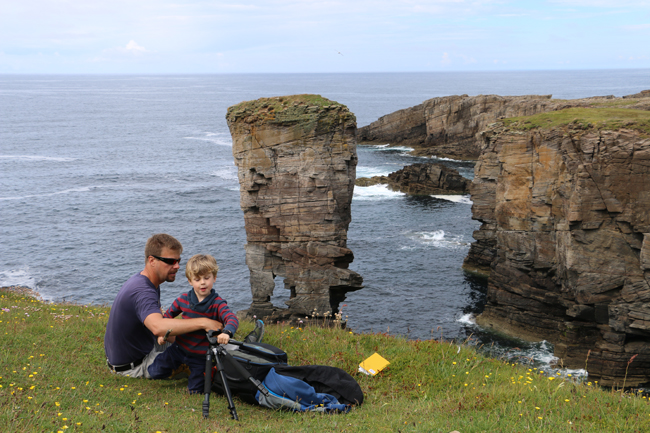
Ahhhh, a raw Scottish coast. …Let’s go there.
There’s sedimentology to be learned here, and coastal geomorphology to be ogled.
This is Yesnaby, on the west side of Orkney. The rocks there are part of “the Old Red Sandstone,” a neat package of Devonian strata, flavored here and there with an igneous dike, a fault, etc. But overall, I’d like to focus on the strata.

The strata I saw at Yesnaby last summer came in two varieties: flagstones and dune sandstones. The flagstones are alternating layers of sandstone and shale, deposited in an ancient lake. They are gently dipping:
Link 0.31 Gpx handheld GigaPan by Callan Bentley
Here’s another coastal outcrop:
Link 0.69 Gpx handheld GigaPan by Callan Bentley

Between the packages of “flags,” there is the “Sandwick Fish Bed,” Fish fossils extracted from these rocks are Eifelian Age (Middle Devonian), and were therefore deposited 398 to 392 million years ago. The images here are from the package below the Sandwick Fish Bed, called the Lower Stromness Flags. This package crops out between the small car parking area and the goal of our visit last summer, Yesnaby Castle.
There’s beautiful sedimentary structures to be seen, like these fine examples of bioturbation – trace fossils etched into the mud and filled in with sand.

On the bedding plane, these burrows appear as semi-cylindrical wiggly-squigglies:

Here’s an example of soft sediment deformation within some of the Lower Stromness Flags’ strata:

Oscillation ripple marks indicate shallow water conditions:

These are (weathered out) mud-chip rip up clasts included within a sandstone:

They suggest a story of changing water energy: calm conditions to deposit the mud, then energetic conditions to rip up the chunks of self-cohesive mud, and bring in the sand to mix them in with.
Further down the coast is a sequence of aeolian strata that are probably the same age, though (because they are coastal dune deposits) they aren’t as fossiliferous and thus aren’t as easy to date. They crop out in dramatic sea stacks and cliffs:

Zooming in, you can see the cross-bedding:


And of course there are nice “storm beach” examples along the tops of these cliffs.
Does it count as a sea stack if there’s a tiny little 2 foot wide “bridge” connecting it to the headland?

This particular sea stack has a dramatic name — Yesnaby Castle — and it has a dramatic story to tell:

Yesnaby Castle in the medium of GigaPan, two views:
Link 0.92 Gpx GigaPan by Callan Bentley
Link 0.37 Gpx GigaPan by Callan Bentley
If you zoom in on it, you’ll find excellent examples of large-scale cross-bedding:

The implication of these structures is a series of coastal dunes adjacent to the lake wherein the Stromness Flags were deposited.
Here’s my field assistant and I setting up the GigaPan to capture this extraordinary feature:

…Thanks for joining us for this virtual day in the field!
